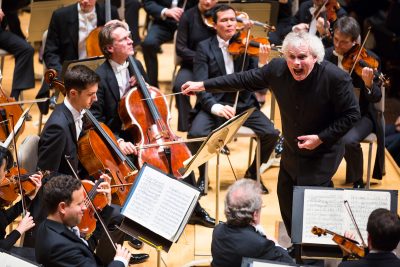
It began with Éclat, a piece composed by Pierre Boulez. Fifteen musicians lined the stage, playing mind-bending harmonies that reverberated, faded and danced around each other. The piece faded into silence, and the audience broke out into applause. Another silence. And so began the tumultuous, emotional and paradoxical journey of Mahler’s Symphony No. 7.
The Berliner Philharmoniker performed at the Boston Symphony Hall on Friday for its final tour with its legendary conductor and artistic director, Sir Simon Rattle. Although its base is in Germany, the Berliner Philharmoniker is an international orchestra. While it retains its distinct sound, its players hail from all over the world, including the United States, Japan and Israel.
“This is an orchestra that has, from every section and every instrument, players of the highest caliber,” said Noah Bendix-Balgley, concertmaster of the Berliner Philharmoniker. “It’s very active and made up of people of very individual personalities, and I think it comes through when the orchestra performs.”
While Rattle conducted the musicians, Bendix-Balgley played with passion and grace as the leader of the first violin section.
His role is historical.
Bendix-Balgley is the first American-born concertmaster of the Berliner Philharmoniker, an orchestra that has been around since 1882. Born in North Carolina, Bendix-Balgley earned the position in 2014, leaving his concertmaster position at another renowned ensemble, the Pittsburgh Symphony Orchestra.
“I had a wonderful time in Pittsburgh, but for me, I always had a dream of playing in the Berliner Philharmonic,” he said. “It was an orchestra that I had always looked up to and admired so much.”
Bendix-Balgley started playing violin at age 4, and at age 9, he performed for Lord Yehudi Menuhin in Switzerland, according to his website.
“The fact that it worked out and I was able to come here as concertmaster is incredibly exciting,” he said. “It’s really an incredibly fun place to play and to work.”
Although the position did come with great honor, there was also a significant learning curve, he said.
There is, Bendix-Balgley said, a particular sound and style that this German orchestra has retained throughout the years. Part of this distinctive sound comes from cultural characteristics, such as the different instruments they use and the different approaches they take to certain kinds of music, he said. But there’s certainly a distinction between an American orchestra and a German orchestra.
“In terms of sound, there are definite differences,” Bendix-Balgley said. “Some of the instruments used, for example, the woodwinds and the brass, are a little different, different sound. Stylistically, I find that especially if you go back to the more classical works, there’s a bit of a different approach.”
Additionally, in contrast to an American orchestra, the Berliner Philharmoniker has a greater emphasis on encouraging its members to pursue other musical activities in addition to their jobs as orchestra musicians. The flexibility comes from the orchestra’s large numbers. For example, there are three concertmaster positions and two principals for each brass and string section. The players rotate; while one is playing in the orchestra, the other pursues independent repertoire in a different setting. Many, like Bendix-Balgley, pursue their soloist careers, while others perform in chamber groups.
Despite each of their different paths, the group must come together to create a cohesive environment.
Because most of the music the orchestra plays is from the work of past composers, the musicians must understand how to play the piece creatively while still preserving the original style, Bendix-Balgley said.
“Our job is to take this document — the score of the composer — and bring it to life, to try to really understand what were they going through, what they’re feeling, what they’re thinking,” he said. “And then of course to bring your own emotion to it.”
But the emotion comes more naturally — the multifaceted nature of each player’s musical career brings renewed energy to the performance of the orchestra, Bendix-Balgley said.
“When they come back to the orchestra, there’s an energy and enthusiasm to make music all together again, which is exciting,” he said.
The group’s drive and passion keeps the orchestra lively. Although many may think classical music is fading into history, Bendix-Balgley said he thought it was all about “exposure and education.” With the rise of technology and social media fluency, he said it’s much easier to discover the beauty of the traditional art.
“It’s not as dire as people make it out to be,” he said. “Make sure that young people are able to hear this music and able to learn about it. The great part of classical music is that it’s deeper and more complex, and you can really experience something that you can’t get from words.”




